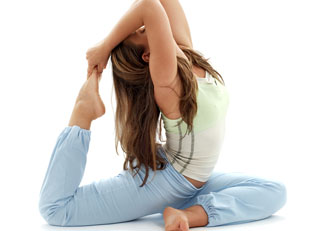History
Iyengar Yoga is named after its creator, B.K.S. Iyengar. As a form of Hatha Yoga, it strives to improve the mind-body connection through asanas and pranayama. Iyengar was born in 1918 in Karnataka, India. Iyengar was a student of legendary yoga guru, T. Krishnamacharya, whom Iyengar studied with from age 14 to age 18.
At age 18, Iyengar began spreading his knowledge to others in Pune. During this process, he experimented with sequences and positions, slowly creating his own style of yoga. Iyengar is the author of several books on yoga, including "Light on Yoga," which is considered a definitive yoga text.
Overall, Iyengar has written 14 books on yoga and philosophy, many of which have been international best-sellers. Iyengar Yoga studios can be found all over the world. Many people consider Iyengar to be responsible for yoga's current popularity. In fact, "Time Magazine" named him one of the 100 most influential people in 2004.
Basic Principles
Iyengar Yoga is a type of Hatha Yoga. Like other variations of Hatha Yoga, it strives to perfect the mind-body connection. This helps improve physical strength, mental spirit and general well-being. Many people consider this an effective method for managing the everyday stress experienced in modern living.
Iyengar Yoga is based on the 8 limbs of yoga as described in the Yoga Sutras of Patanjali. Two of these 8 limbs include asanas, or postures, and pranayama, or breathing. Both asana and pranayama integrate the mind and body. In Iyengar Yoga, asana and pranayama are used to master all 8 aspects. As you learn to master subtle and controlled breathing, the mind becomes steady as well.
There are 3 ways in which Iyengar Yoga differs from other types of yoga. One is the focus on technique. Iyengar Yoga incorporates props, such as blocks, belts and cushions. Using these props allows you to focus on proper alignment of the body. Beginners are able to practice asanas more easily while still experiencing the benefits of the pose. The second difference from other methods is the use of specific sequences. Iyengar Yoga incorporates specific sequences of asanas and pranayama. Following these in a specific order leads to addition health benefits. The final way Iyengar Yoga differs is in the timing. Poses are held for longer periods of time and are corrected by an instructor, unlike other self-directed forms of yoga.
Poses
Iyengar Yoga incorporates over 200 yoga poses along with 14 different pranayama. The sequence of poses is especially important and designed for beginners through advanced students. Students move from simple poses to very difficult poses in a precisely structured way. This progression allows you to gain strength, flexibility and sensitivity.
The focus in the practice of asanas is on proper body alignment. This allows the student to develop in an anatomically correct way, which minimizes injuries and pain. The use of props is important in minimizing injuries and practicing asanas in a safe, yet effective way.
Iyengar Yoga includes both standing and sitting poses. Common poses include downward facing dog pose, headstand pose, warrior pose and triangle pose. Standing poses are often emphasized as they increase vitality, build strong legs, improve circulation and increase balance. These skills then become the foundation of more advanced poses.
Regardless of the pose, the sequence of asanas and pranayama intensifies the healing effects. Studies have shown that people practicing Iyengar Yoga experience less pain from physical ailments and experience decreased mental illness, including anger, anxiety and depression.
Who This is For
Everyone can see benefits from Iyengar Yoga. Because of the props, even the physically limited can participate. However, it is important to find a teacher who is certified to teach Iyengar Yoga., which requires 2 years of study to teach at the introductory level. Specific programs of Iyengar Yoga have been developed to treat various disease and injuries. Additionally, asanas can be adjusted to meet people at their level of recovery.
While Iyengar Yoga is effective for the eldery and injured, the more advanced sequences offer challenges for more advanced students. Instructors at these levels have often received over 10 years of training. Iyengar Yoga is unique in its ability to improve the minds and bodies of everyone.



